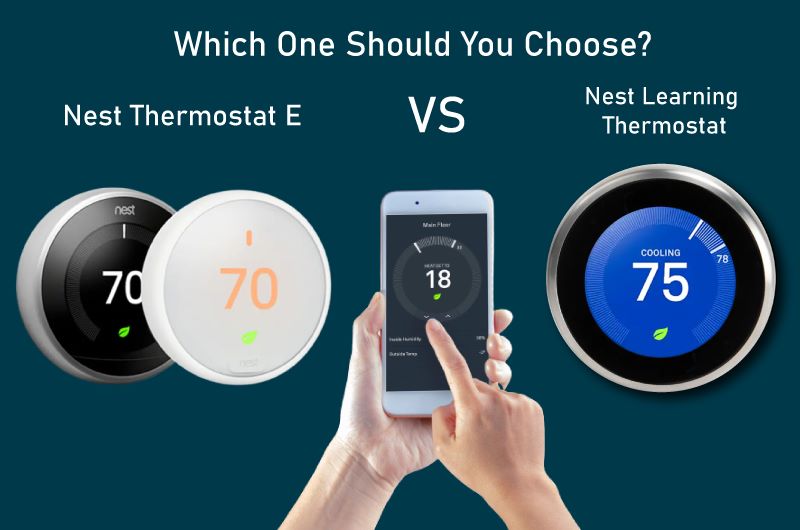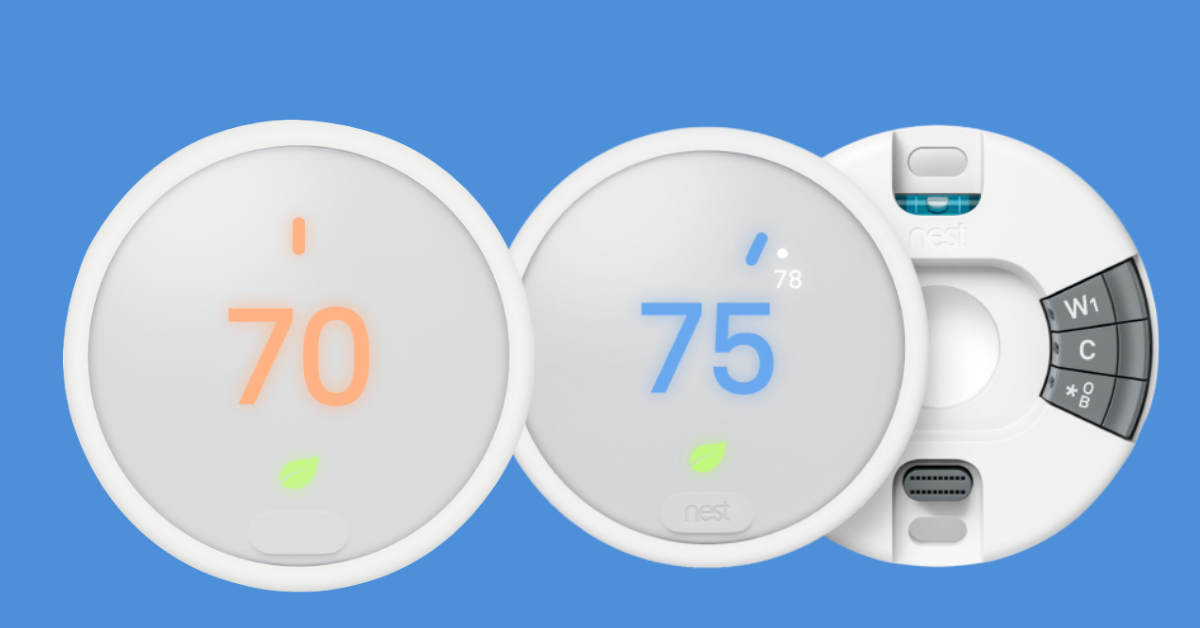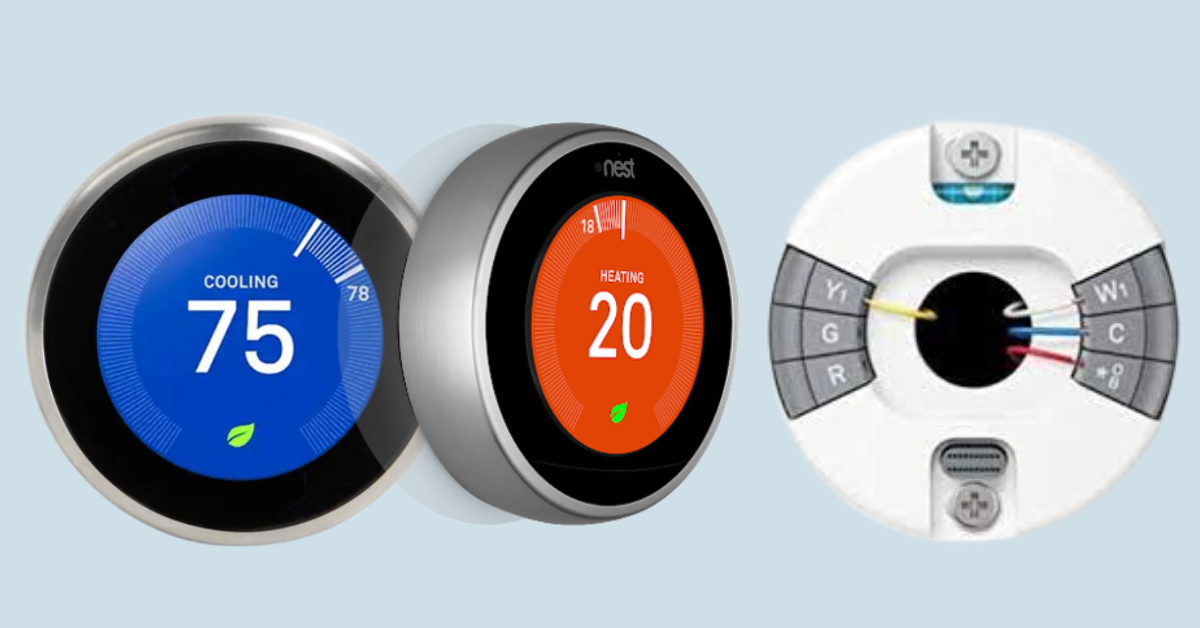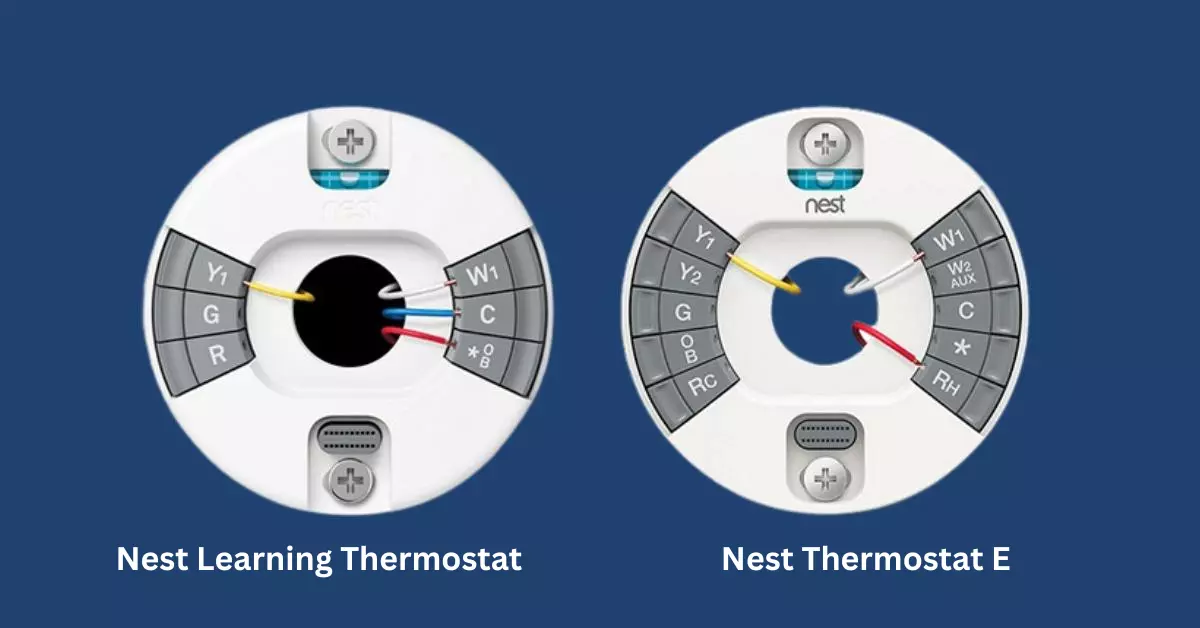
Smart thermostats play a crucial role in enhancing energy efficiency and enabling home automation. These innovative devices offer precise control over heating and cooling systems. Helping homeowners reduce energy waste and lower utility bills. Among the leading brands, Nest thermostats have gained immense popularity for their cutting-edge features and intuitive interfaces. In this article, we will focus on comparing two popular Nest thermostat models: the Nest Thermostat E and the Nest Learning Thermostat. By exploring their unique characteristics and benefits, you can determine which option suits your specific needs and preferences.
Nest Thermostat E

Nest Thermostat E
The Nest Thermostat E is a smart and energy-efficient thermostat. Designed to simplify temperature control in homes. With its sleek and minimalist design seamlessly blends into any living space. The Energy-saving mode is a standout feature. Automatically adjusting settings to conserve energy when you’re away. The Nest Thermostat E is compatible with most HVAC systems and can be easily installed. Its intuitive interface and compatibility with the Nest mobile app allow for convenient remote control. By choosing the Nest Thermostat E, users can enjoy energy savings, personalized scheduling. And the ability to create a comfortable home environment while reducing their carbon footprint. You may know more about Nest Thermostats.
Nest Learning Thermostat

Nest Learning Thermostat
The Nest Learning Thermostat is a revolutionary smart thermostat. That goes beyond basic temperature control. It features advanced learning capabilities, constantly adapting to your preferences and schedule. Analyzing your patterns creates a personalized temperature schedule that maximizes comfort and energy efficiency. The thermostat’s compatibility with various HVAC systems ensures seamless integration into any home. Its advanced scheduling options allow for precise control. Ensuring the perfect temperature at all times. The Nest Learning Thermostat offers benefits such as energy savings, remote control via the Nest app, and smart home integration with popular platforms. Choosing the Nest Learning Thermostat means enjoying a truly intelligent and energy-efficient solution for optimizing home comfort.
Comparison of Nest Thermostat E and Nest Learning Thermostat
Key Features |
Nest Thermostat E |
Nest Learning Thermostat |
|---|---|---|
| Installation Process | Simple and user-friendly setup process. | Hassle-free installation with step-by-step guidance |
| Display | Frosted display that blends into any decor. | High-resolution color display for detailed visibility |
| Compatibility with HVAC | Compatible with most heating and cooling systems. | Supports a wide range of HVAC systems, including multi-stage and heat pumps. |
| Sensors | Temperature, humidity, proximity. | Temperature, humidity, proximity, occupancy. |
| Connectivity | Wi-Fi connectivity for remote control. | Wi-Fi connectivity for remote control. |
| Colors | White | Stainless Steel, Copper, Black. |
| Features | Energy-saving mode, and manual scheduling. | Learning capabilities, advanced scheduling, energy-saving mode |
| Smart Home Integration | Integrates with popular platforms like Google Assistant and Amazon Alexa. | Offers compatibility with Google Assistant, Amazon Alexa, and Apple HomeKit |
| App Connectivity | Control and monitor the thermostat via the Nest app. | Control and monitor the thermostat via the Nest app |
| Impact on User Experience | Convenient control, remote access, and energy-saving options. | Enhanced user experience, personalized scheduling, energy optimization |
| Impact on Energy Efficiency | Reduces energy waste through scheduling and energy-saving mode. | Optimizes energy usage with learning algorithms, occupancy detection, and remote control |
These features can impact the user experience and energy efficiency in the following ways:
- Installation Process: Easy installation impacts the speed and usability of thermostats. DIY installation saves time and money. While professional installation ensures compatibility and functionality.
- Display: A backlight or color touchscreen display can enhance visibility and user-friendliness. Clear and intuitive displays make it easier to read and adjust settings, improving the overall user experience.
- Compatibility with HVAC Systems: Compatibility with a wide range of HVAC systems allows for broader usage and ease of integration. Specific compatibility may limit options and require additional adjustments or equipment.
- Smart Home Integration: Integration with popular smart home systems enables convenient control and automation. Allowing users to create energy-saving schedules and remotely manage their thermostats. Limited smart home integration may restrict the functionality and reduce the potential for energy efficiency.
- Color: While color is mainly a visual preference, it can play a role in how well the thermostat blends with the surrounding décor. Harmonious aesthetics can contribute to a positive user experience.
- Battery Capacity: Battery operation or a rechargeable battery ensures thermostat functionality during power outages. Longer battery life maintains continuous operation and prevents loss of settings.
- Power Capacity and Sensors: Higher power capacity and advanced sensors can improve the thermostat’s performance and accuracy in measuring temperature and detecting occupancy. This can optimize energy efficiency by ensuring precise control and avoiding unnecessary heating or cooling.
- App Connectivity: Mobile apps enable remote control and scheduling of thermostats, allowing users to manage them from anywhere. Advanced app features, like energy usage tracking and AI-based recommendations, enhance energy efficiency by providing insights and optimization suggestions.
Based on the above comparison
Both thermostats offer energy-saving modes and compatibility with popular smart home platforms. Promoting energy efficiency and seamless integration into smart home systems. Nest Learning Thermostat learns from user patterns and adjusts temperature based on occupancy for enhanced energy efficiency. By considering these features, users can make an informed decision based on their specific needs and preferences.
Energy Efficiency and Cost Savings
Energy-saving Features and Cost Reduction: Both the Nest Thermostat E and Nest Learning Thermostat come equipped with energy-saving features. That can significantly reduce utility bills. They optimize energy usage through scheduling, learning algorithms, and sensor technology.
Scheduling: Users can create personalized schedules to adjust the temperature based on their daily routines. This eliminates unnecessary heating or cooling when the house is unoccupied. And resulting in energy savings.
Learning Algorithms: The Nest Learning Thermostat takes energy efficiency a step. It learns users’ temperature preferences and automatically adjusts the settings accordingly. Optimizing comfort while minimizing energy waste.
Sensor Technology: Both thermostats utilize built-in sensors to detect occupancy and adjust the temperature accordingly. When the house is empty, the thermostats can enter an energy-saving mode to conserve energy.
Studies have shown significant cost savings with the use of Nest thermostats.
According to Nest, their thermostats can save an average of 10-12% on heating bills and 15% on cooling bills. A study conducted by Energy Trust of Oregon revealed that Nest thermostats saved an average of 12% on heating and 15% on cooling, resulting in an annual savings of $131 to $145.
[Source- store.google.com]
By utilizing these energy-saving features, users can not only reduce their carbon footprint but also enjoy substantial cost savings on their utility bills.
User-Friendliness and Smart Home Integration
Both the Nest Thermostat E and Nest Learning Thermostat offer user-friendly interfaces, mobile apps, and seamless integration with popular smart home platforms.
Interface and Mobile App: The thermostats feature intuitive interfaces, allowing users to easily adjust temperature settings and access advanced features. The mobile apps provide convenient remote control. Enabling users to monitor and manage their thermostats from anywhere. More Smart Thermostats for home are available here.
Smart Home Compatibility: Both thermostats are compatible with Google Assistant, Amazon Alexa, and Apple HomeKit. Offering voice control capabilities and integration with other smart home devices. Users can effortlessly control their thermostats through voice commands or automate temperature adjustments.
Additional Features: The Nest Learning Thermostat and Nest Thermostat E offer additional features that enhance the user experience. These include energy usage reports, remote access, and geofencing for automatic adjustments based on user location. And compatibility with additional smart home devices. With temperature Sensors, you can monitor and control the temperature in different rooms.
How to choose between the Nest Learning Thermostat Vs. Nest Thermostat E?

Nest Learning Thermostat Vs. Nest Thermostat E
When choosing between the Nest Learning Thermostat and Nest Thermostat, there are several factors to consider.
- Examine the features offered by each thermostat. The Nest Learning Thermostat is equipped with advanced features such as learning capabilities, occupancy sensors, and extensive integration options. On the other hand, the Nest Thermostat may have a more streamlined feature set but still provides smart functionality.
- Take your budget into account. The Nest Learning Thermostat typically comes at a higher price point due to its advanced features. While the Nest Thermostat may be a more affordable option.
- Consider the specific requirements of your home setup. If you require multi-room management capabilities, the Nest Learning Thermostat supports this feature. However, if single-room management is sufficient for your needs, the Nest Thermostat may be a suitable choice.
- Personal preferences also play a role in the decision-making process. Take into account factors such as aesthetics, display type, and user interface. Each thermostat has its own design and user experience. So choose the one that aligns with your preferences and complements your home decor.
- Ensure that the thermostat you choose is compatible with your HVAC system. Review the compatibility requirements provided by the manufacturer and verify if your system meets those requirements.
By thoroughly considering these factors – including features, budget, home setup, personal preferences, and compatibility. You can make an informed decision that suits your specific needs and enhances your home’s energy management.
The Bottom Line
Make an informed decision by evaluating your specific requirements. Both the Nest Thermostat E and Nest Learning Thermostat offer energy-saving features, user-friendly interfaces, and smart home integration. Consider the level of customization and optimization you desire. As well as compatibility with your existing smart home ecosystem. Choose the thermostat that best aligns with your needs and preferences. And enjoy the benefits of energy efficiency and enhanced comfort in your home.
Check Out The Nest Thermostat With Live Price On Amazon








